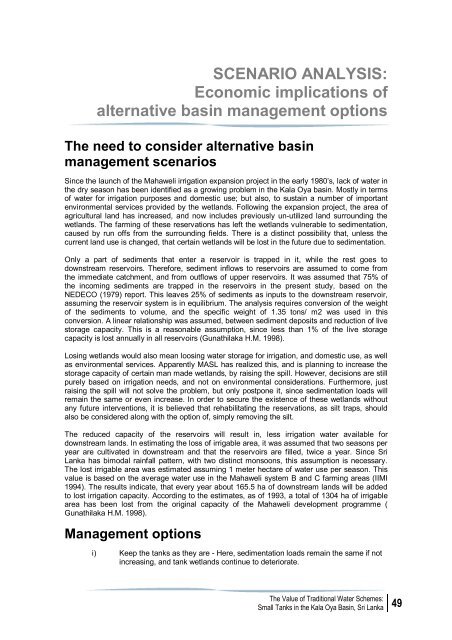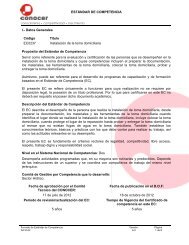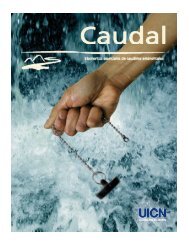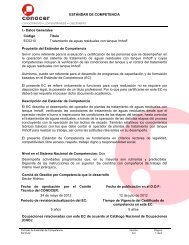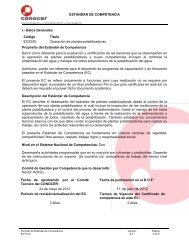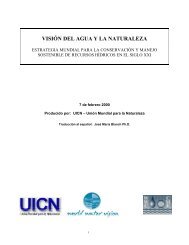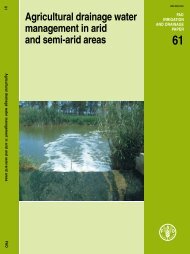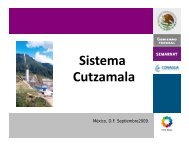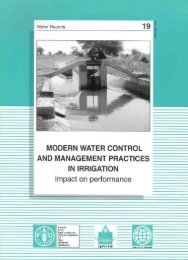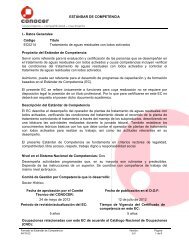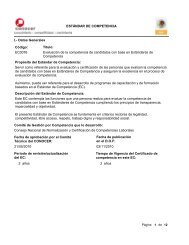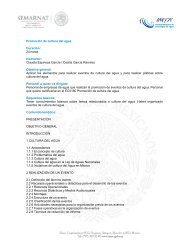Document - IUCN
Document - IUCN
Document - IUCN
Create successful ePaper yourself
Turn your PDF publications into a flip-book with our unique Google optimized e-Paper software.
SCENARIO ANALYSIS:Economic implications ofalternative basin management optionsThe need to consider alternative basinmanagement scenariosSince the launch of the Mahaweli irrigation expansion project in the early 1980’s, lack of water inthe dry season has been identified as a growing problem in the Kala Oya basin. Mostly in termsof water for irrigation purposes and domestic use; but also, to sustain a number of importantenvironmental services provided by the wetlands. Following the expansion project, the area ofagricultural land has increased, and now includes previously un-utilized land surrounding thewetlands. The farming of these reservations has left the wetlands vulnerable to sedimentation,caused by run offs from the surrounding fields. There is a distinct possibility that, unless thecurrent land use is changed, that certain wetlands will be lost in the future due to sedimentation.Only a part of sediments that enter a reservoir is trapped in it, while the rest goes todownstream reservoirs. Therefore, sediment inflows to reservoirs are assumed to come fromthe immediate catchment, and from outflows of upper reservoirs. It was assumed that 75% ofthe incoming sediments are trapped in the reservoirs in the present study, based on theNEDECO (1979) report. This leaves 25% of sediments as inputs to the downstream reservoir,assuming the reservoir system is in equilibrium. The analysis requires conversion of the weightof the sediments to volume, and the specific weight of 1.35 tons/ m2 was used in thisconversion. A linear relationship was assumed, between sediment deposits and reduction of livestorage capacity. This is a reasonable assumption, since less than 1% of the live storagecapacity is lost annually in all reservoirs (Gunathilaka H.M. 1998).Losing wetlands would also mean loosing water storage for irrigation, and domestic use, as wellas environmental services. Apparently MASL has realized this, and is planning to increase thestorage capacity of certain man made wetlands, by raising the spill. However, decisions are stillpurely based on irrigation needs, and not on environmental considerations. Furthermore, justraising the spill will not solve the problem, but only postpone it, since sedimentation loads willremain the same or even increase. In order to secure the existence of these wetlands withoutany future interventions, it is believed that rehabilitating the reservations, as silt traps, shouldalso be considered along with the option of, simply removing the silt.The reduced capacity of the reservoirs will result in, less irrigation water available fordownstream lands. In estimating the loss of irrigable area, it was assumed that two seasons peryear are cultivated in downstream and that the reservoirs are filled, twice a year. Since SriLanka has bimodal rainfall pattern, with two distinct monsoons, this assumption is necessary.The lost irrigable area was estimated assuming 1 meter hectare of water use per season. Thisvalue is based on the average water use in the Mahaweli system B and C farming areas (IIMI1994). The results indicate, that every year about 165.5 ha of downstream lands will be addedto lost irrigation capacity. According to the estimates, as of 1993, a total of 1304 ha of irrigablearea has been lost from the original capacity of the Mahaweli development programme (Gunathilaka H.M. 1998).Management optionsi) Keep the tanks as they are - Here, sedimentation loads remain the same if notincreasing, and tank wetlands continue to deteriorate.The Value of Traditional Water Schemes:Small Tanks in the Kala Oya Basin, Sri Lanka49


